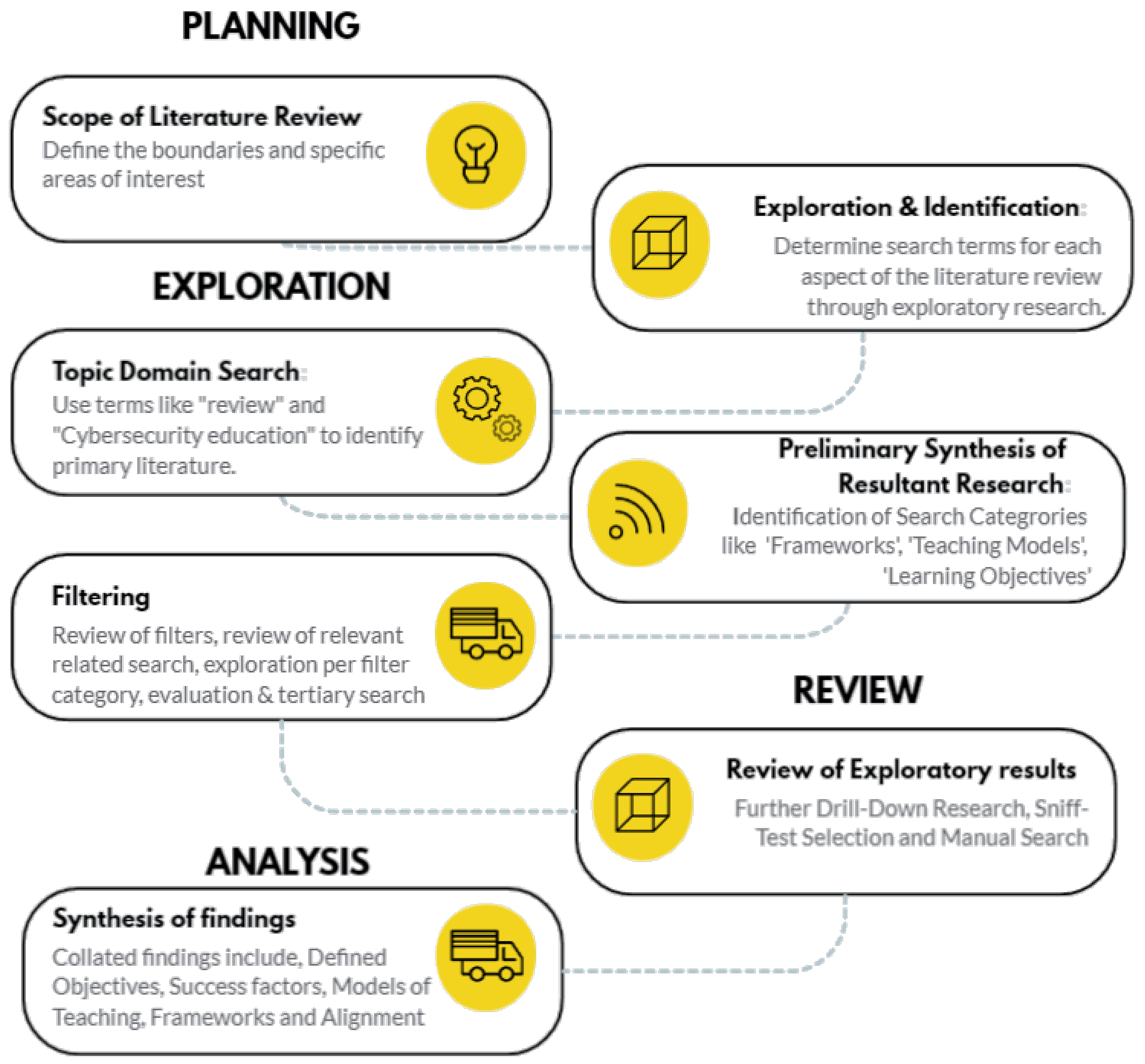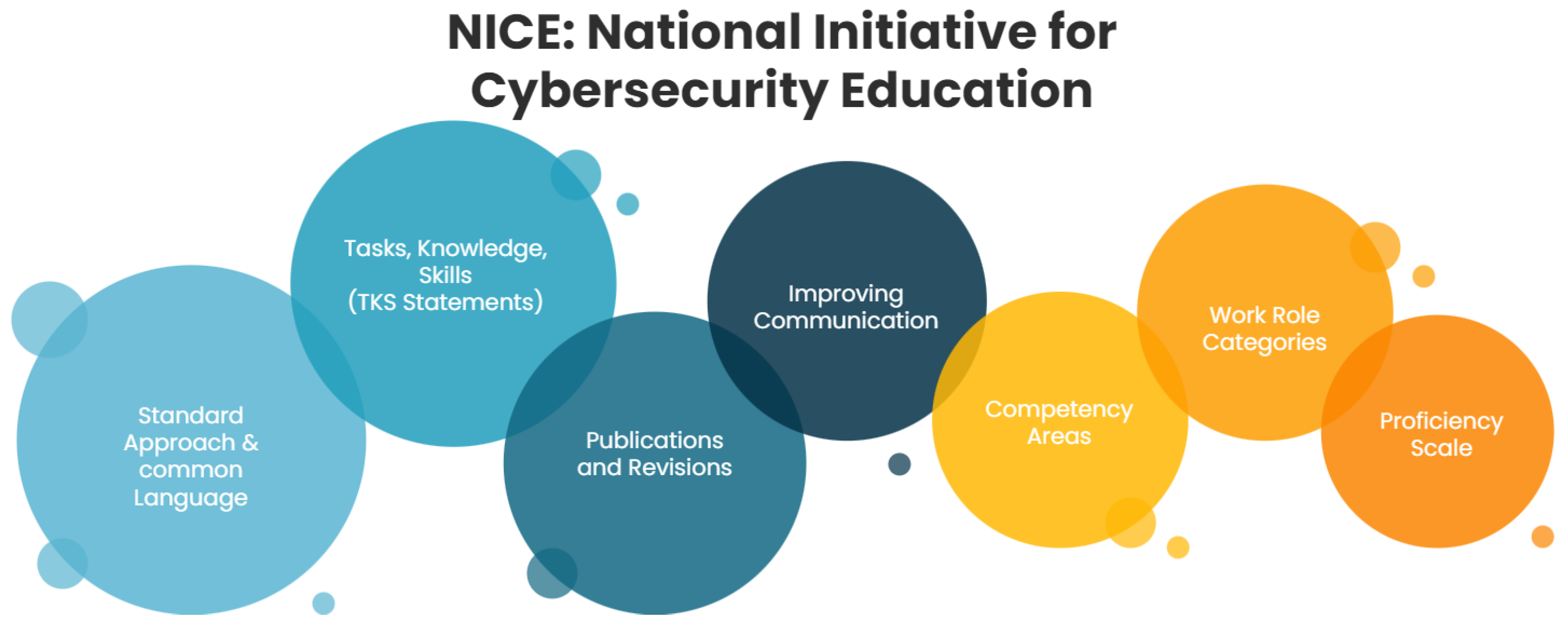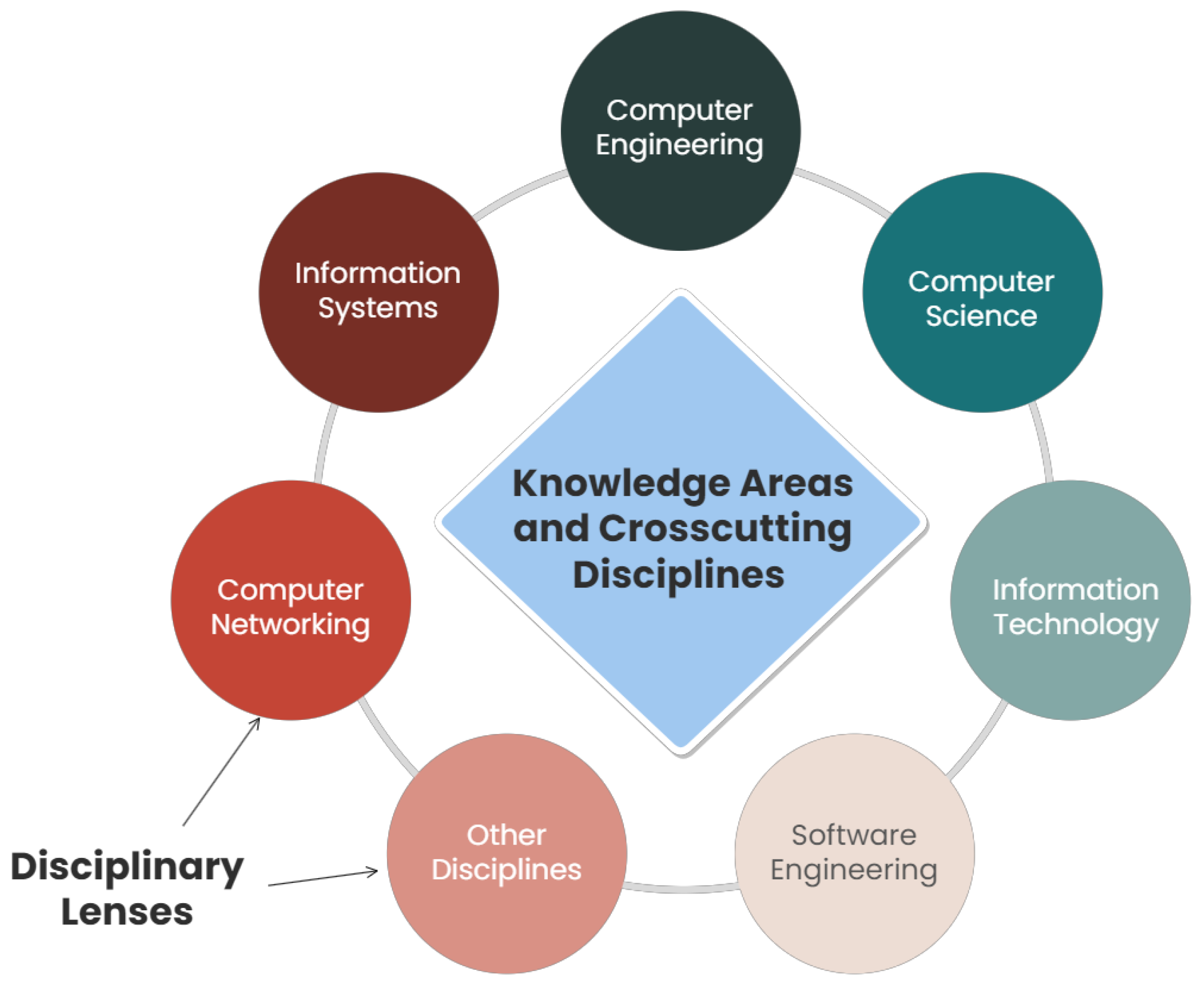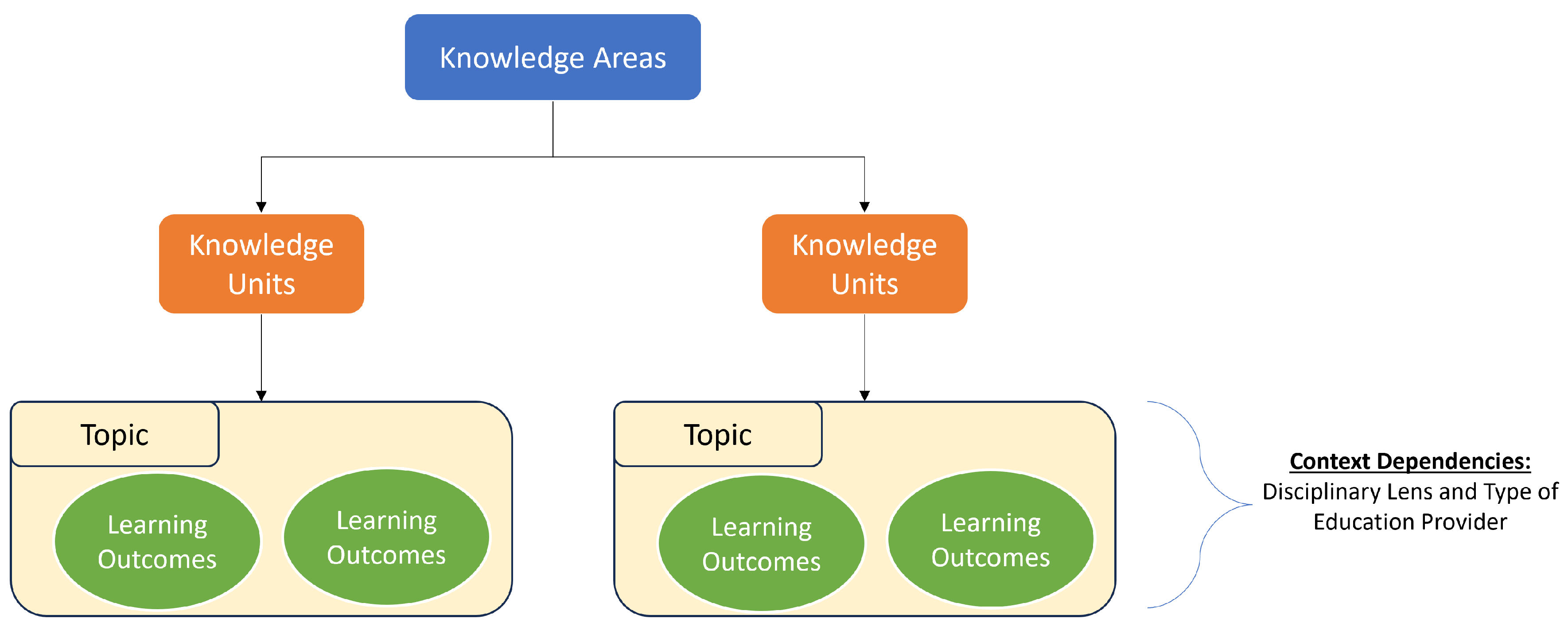Strategic Approaches to Cybersecurity Learning: A Study of Educational Models and Outcomes
Abstract
:1. Introduction
2. Methodology
2.1. Definition of Scope and Review Criteria
2.2. Parsing Available Repositories
2.3. Preliminary Synthesis of Resultant Research
2.4. Further Drill down Research
2.5. Selection Filters
2.6. Synthesis of Findings
2.7. Report Findings and Recommendations
2.8. Identification of Gaps and Suggested Future Work
3. Related Work
3.1. Landscape of Cybersecurity Education
3.2. The Existing Literature
3.3. Analysis of Pedagogical Models
3.4. Industry Alignment and Certification Bodies
3.5. The Aim of This Research
4. Cybersecurity Education Frameworks
4.1. NICE Framework
4.2. ECSF Framework
- Assess the potential impact of the ECSF on standardizing cybersecurity education and training across Europe.
- Explore methods through which the ECSF aims to connect professional workplaces with learning environments.
- Explore the European Cybersecurity Skills Academy and how it plans to utilize the ECSF to tackle the cybersecurity talent shortage in the EU.
4.3. ACM/IEEE: The Joint Task Force Cybersecurity Curricula 2017
4.4. Comparative Analysis
5. Education Models
5.1. Problem-Based Learning
5.2. Project-Based Learning
5.3. Hands-on Learning
5.4. Experiential Learning
5.5. Flipped Classroom Model
5.6. Case-Based Learning
6. Identification of Objectives
6.1. Validation of the Identified Objectives
6.2. Identified General Model Learning Objectives
- Student engagement: We aim to address the overall attention, intrinsic motivation and interactivity of the student base in relation to the taught subject.
- Student retention: This aims to address the pervasive problem of dropouts and professional aversion to the industry.
- Knowledge retention: This refers to the transferability of knowledge to the learner and their ability to grasp the concepts and analyze and apply them [61] in the later stages of their careers with or without continuity of exposure.
- Diversification and multi-disciplinary: Here, we mean the diversity of concepts that can be taught with a particular model effectively, where a multi-disciplinary field like cybersecurity can have certain aspects taught fairly well with one methodology while other methods can be hindered within those parameters. For example, intrusion prevention and detection taught using hands-on learning will have a much better result in student outcomes than if taught using a theory-based flipped classroom approach.
- Transferability and transposeability of a model: This is the extent to which the effect of a particular model can be replicated in another setting. This can include considerations of financial resources, infrastructure resources, time the and mode of instruction.
7. Findings and Recommendations
7.1. Model Analysis
7.2. Common Findings
- Exposure to a variety of topics:
- o
- A multi-disciplinary approach is deemed imperative for a truly work-ready graduates in cybersecurity, a multidisciplinary field.
- o
- This has the added benefit of ensuring learners are cognizant of the various roles in cybersecurity and their tasks and requirements.
- o
- This exposes students to various avenues of pursuit should they seek advancement in a particular field of interest or specialization. This can be a further education pathway or pursuit of a specific role in the industry.
This aligns with the impetus behind the definition of learning pathways and skills within each of the reference frameworks. - Application-based learning opportunities:
- o
- To be considered work-ready for a field like cybersecurity requires comprehension of the relevant areas, and this is best demonstrated through the following:
- –
- Application of previously learned topics;
- –
- Hands-on tasks;
- –
- Work-integrated learning opportunities.
This is meant to simplify aligning with the competency requirements defined in each reference framework.
- Compatibility and suitability: In different learning contexts, one may find specific aspects of each model and mode of delivery enticing to their own needs, but the primary criteria should be the following:
- o
- Compatibility of a model to the mode of delivery;
- o
- Suitability of the model to the subject matter, classroom size and overall learning context.
This is where most frameworks fall short, as they are too generalized to address the varying barriers and opportunities across learning contexts. Through this review, our work will aggregate these learning contexts based on the level of educational support and based on the material and environmental limitations of the learner and education provider.
7.3. Determine the Level of Scaffolding and Barriers
7.3.1. Low Scaffolding, Low Barriers
7.3.2. Low Scaffolding, High Barriers
7.3.3. High Scaffolding, Low Barriers
7.3.4. High Scaffolding, High Barriers
7.4. Evaluating the Teaching Models
7.5. Decision
- If the environment has low scaffolding and low barriers, then prioritize problem-based learning, project-based learning and case-based teaching.
- If the environment has low scaffolding and high barriers, then consider avoiding hands-on learning, experiential learning and the flipped classroom model.
- If the environment has high scaffolding and low barriers, then most models are suitable, with a special emphasis on models that require the necessary resources.
- If the environment has high scaffolding and high barriers, then be cautious with all models and consider the specific barriers before implementation. Models like the flipped classroom model work well when the education material is provided, and there are geographical barriers or physical barriers.
8. Limitations
9. Conclusions
Author Contributions
Funding
Institutional Review Board Statement
Informed Consent Statement
Data Availability Statement
Conflicts of Interest
Abbreviations
| ISC2 | International Information Systems Security Certification Consortium’s |
| MOOCs | Massive open online sourses |
| NIST | National Institute of Standards and Technology’s |
| NICE | National Initiative for Cybersecurity Education’s Framework |
| IEEE | Institute of Electrical and Electronics Engineers |
| ACM | Association for Computing Machinery |
| CSEC2017 | ACM/IEEE Joint Task Force Cybersecurity Curricula 2017 |
| ECSO | European Cybersecurity Organisation |
| ECSF | European Cybersecurity Skills Framework |
| OPM | Office of Personnel Management |
| CyRIS | Cyber Range Instantiation System |
| SANS | SysAdmin, Audit, Network, and Security |
| ISACA | Information Systems Audit and Control Association |
| KSAs | Knowledge, skills and abilities |
| TSKs | Tasks, knowledge and skills |
| ENISA | The European Union Agency for Cybersecurity |
| ECCC | European Cybersecurity Competence Centre |
References
- ISC2. Cybersecurity Workforce Study 2022. 2022. Available online: https://www.isc2.org/research (accessed on 16 May 2023).
- European Cybersecurity Organisation. European Cybersecurity Education and Professional Training: Minimum Reference Curriculum. 2022. Available online: https://ecs-org.eu/ecso-uploads/2022/12/2022_SWG5.2_Minimum_Reference_Curriculum_final_v3.0.pdf (accessed on 16 May 2023).
- European Cybersecurity Organisation. Gaps in European Cyber Education and Professional Training. 2017. Available online: https://ecs-org.eu/ecso-uploads/2022/10/5fdb282a4dcbd-1.pdf (accessed on 16 May 2023).
- ENISA. About ENISA. 2019. Available online: https://www.enisa.europa.eu/about-enisa (accessed on 16 May 2023).
- Australian Computer Society. Cybersecurity Pathway Chart. Available online: https://www.acs.org.au/content/dam/acs/acs-documents/ACS-CP-CyberSecurity-Pathway-Chart.pdf (accessed on 16 May 2023).
- Skills Framework for the Information Age. Information and Cyber Security. Available online: https://sfia-online.org/en/sfia-8/sfia-views/information-and-cyber-security?path=/glance (accessed on 16 May 2023).
- Communication on the Cybersecurity Skills Academy. 2023. Available online: https://digital-strategy.ec.europa.eu/en/library/communication-cybersecurity-skills-academy (accessed on 13 April 2023).
- Cybersecurity Curricula 2017: Curriculum Guidelines for Undergraduate Degree Programs in Cybersecurity. Technical Report Draft Version 0.5, ACM Joint Task Force on Cybersecurity Education. 2017. Available online: http://www.csec2017.org/csec2017-v-0-5 (accessed on 16 May 2023).
- Newhouse, W.; Keith, S.; Scribner, B.; Witte, G. National Initiative for Cybersecurity Education (NICE) Cybersecurity Workforce Framework; U.S. Department of Commerce: Gaithersburg, MD, USA, 2017; NIST Special Publication, Volume 800-181 Revision 1.
- European Cybersecurity Skills Framework (ECSF). 2023. Available online: https://www.enisa.europa.eu/topics/education/european-cybersecurity-skills-framework (accessed on 16 May 2023).
- Dini, P.; Elhanashi, A.; Begni, A.; Saponara, S.; Zheng, Q.; Gasmi, K. Overview on Intrusion Detection Systems Design Exploiting Machine Learning for Networking Cybersecurity. Appl. Sci. 2023, 13, 7507. [Google Scholar] [CrossRef]
- Workman, M.D.; Luévanos, J.A.; Mai, B. A study of cybersecurity education using a present-test-practice-assess model. IEEE Trans. Educ. 2021, 65, 40–45. [Google Scholar] [CrossRef]
- Beuran, R.; Chinen, K.I.; Tan, Y.; Shinoda, Y. Towards Effective Cybersecurity Education and Training; Japan Advanced Institute of Science and Technology: Ishikawa, Japan, 14 October 2016. [Google Scholar]
- Kim, E.; Beuran, R. On designing a cybersecurity educational program for higher education. In Proceedings of the 10th International Conference on Education Technology and Computers, Tokyo, Japan, 26–28 October 2018; pp. 195–200. [Google Scholar]
- Tamur, M.; Mandur, K.; Pareira, J. Do combination learning models change the study effect size? A meta-analysis of contextual teaching and learning. J. Educ. Expert. 2021, 4, 1–9. [Google Scholar]
- Cabaj, K.; Domingos, D.; Kotulski, Z.; Respício, A. Cybersecurity education: Evolution of the discipline and analysis of master programs. Comput. Secur. 2018, 75, 24–35. [Google Scholar] [CrossRef]
- Stavrou, E. Planning for Professional Development in Cybersecurity: A New Curriculum Design. In Proceedings of the International Symposium on Human Aspects of Information Security and Assurance, Kent, UK, 4–6 July 2023; pp. 91–104. [Google Scholar]
- Dragoni, N.; Lafuente, A.L.; Massacci, F.; Schlichtkrull, A. Are we preparing students to build security in? A survey of European cybersecurity in higher education programs. IEEE Secur. Priv. 2021, 19, 81–88. [Google Scholar] [CrossRef]
- Balon, T.; Baggili, I. Cybercompetitions: A survey of competitions, tools, and systems to support cybersecurity education. Educ. Inf. Technol. 2023, 28, 11759–11791. [Google Scholar] [CrossRef] [PubMed]
- Hajny, J.; Ricci, S.; Piesarskas, E.; Levillain, O.; Galletta, L.; De Nicola, R. Framework, tools and good practices for cybersecurity curricula. IEEE Access 2021, 9, 94723–94747. [Google Scholar] [CrossRef]
- Conklin, W.A.; Cline, R.E.; Roosa, T. Re-engineering cybersecurity education in the US: An analysis of the critical factors. In Proceedings of the 2014 47th Hawaii International Conference on System Sciences, Waikoloa, HI, USA, 6–9 January 2014; pp. 2006–2014. [Google Scholar]
- Beuran, R.; Pham, C.; Tang, D.; Chinen, K.I.; Tan, Y.; Shinoda, Y. Cybersecurity education and training support system: CyRIS. IEICE Trans. Inf. Syst. 2018, 101, 740–749. [Google Scholar] [CrossRef]
- Nweke, L.O.; Bokolo, A.J.; Mba, G.; Nwigwe, E. Investigating the effectiveness of a HyFlex cyber security training in a developing country: A case study. Educ. Inf. Technol. 2022, 27, 10107–10133. [Google Scholar] [CrossRef] [PubMed]
- Baldassarre, M.T.; Santa Barletta, V.; Caivano, D.; Raguseo, D.; Scalera, M. Teaching Cyber Security: The HACK-SPACE Integrated Model. In Proceedings of the ITASEC, Pisa, Italy, 13–15 February 2019. [Google Scholar]
- Luo, Z.Y.; Wang, J.Y.; Sun, G.L.; Chen, Y.D. Research on Gamification Teaching of “Network Security Technology” Under Improved Flipping Classroom. In Proceedings of the International Conference on E-Learning, E-Education, and Online Training, Kunming, China, 18–19 August 2019; pp. 36–47. [Google Scholar]
- Suryotrisongko, H.; Musashi, Y. Review of cybersecurity research topics, taxonomy, and challenges: Interdisciplinary perspective. In Proceedings of the 2019 IEEE 12th Conference on Service-Oriented Computing and Applications (SOCA), Kaohsiung, Taiwan, 18–21 November 2019; pp. 162–167. [Google Scholar]
- AlDaajeh, N.; Saleous, N.; Alrabaee, S.; Barka, E.; Breitinger, F.; Choo, K.K.R. The role of national cybersecurity strategies on the improvement of cybersecurity education. Comput. Secur. 2022, 119, 102754. [Google Scholar] [CrossRef]
- Measuring Cybersecurity Workforce Capabilities: Defining a Proficiency Scale for the NICE Framework Table of Contents. 2023. Available online: https://www.nist.gov/system/files/documents/2023/10/05/NIST%20Measuring%20Cybersecurity%20Workforce%20Capabilities%207-25-22.pdf (accessed on 9 October 2023).
- NIST. Events|NICE|Conference and Expo. 2023. Available online: https://niceconference.org/events/ (accessed on 9 October 2023).
- Mouheb, D.; Abbas, S.; Merabti, M. Cybersecurity curriculum design: A survey. In Transactions on Edutainment XV; Springer: Berlin, Germany, 2019; pp. 93–107. [Google Scholar]
- The SANS Institute. Cyber Security Skills Roadmap|SANS Institute: Cyber Security Skills Roadmap. 2019. Available online: https://www.sans.org/cyber-security-skills-roadmap (accessed on 16 May 2023).
- Wetzel, K. NICE Framework Competency Areas: National Institute of Standards and Technology. 2023. Available online: https://nvlpubs.nist.gov/nistpubs/ir/2023/NIST.IR.8355.pdf (accessed on 16 May 2023).
- Petersen, R.; Santos, D.; Smith, M.C.; Wetzel, K.A.; Witte, G. Workforce Framework for Cybersecurity (NICE Framework). National Institute of Standards and Technology. 2020. Available online: https://nvlpubs.nist.gov/nistpubs/SpecialPublications/NIST.SP.800-181r1.pdf (accessed on 22 March 2023).
- Workforce Planning for the Cybersecurity Workforce. U.S. Office of Personnel Management. Available online: https://www.opm.gov/policy-data-oversight/human-capital-management/cybersecurity/ (accessed on 22 March 2023).
- Blažič, B.J. Changing the landscape of cybersecurity education in the EU: Will the new approach produce the required cybersecurity skills? Educ. Inf. Technol. 2021, 27, 3011–3036. [Google Scholar] [CrossRef]
- Ghosh, T.; Francia, G., III. Assessing Competencies Using Scenario-Based Learning in Cybersecurity. J. Cybersecur. Priv. 2021, 1, 539–552. [Google Scholar] [CrossRef]
- Xia, P. Exploration on Open Practice Teaching Mode of Network Security Based on Cultivation of Innovative Talents. In Proceedings of the International Conference on Applications and Techniques in Cyber Security and Intelligence, Fuyang, China, 20–22 June 2020; pp. 172–179. [Google Scholar]
- Sánchez, J.; Mallorquí, A.; Briones, A.; Zaballos, A.; Corral, G. An integral pedagogical strategy for teaching and learning IoT cybersecurity. Sensors 2020, 20, 3970. [Google Scholar] [CrossRef]
- Yew, E.H.; Goh, K. Problem-based learning: An overview of its process and impact on learning. Health Prof. Educ. 2016, 2, 75–79. [Google Scholar] [CrossRef]
- Yang, J.; Rae Kim, Y.; Earwood, B. A Study of Effectiveness and Problem Solving on Security Concepts with Model-Eliciting Activities. In Proceedings of the 2022 IEEE Frontiers in Education Conference (FIE), Uppsala, Sweden, 8–11 October 2022. [Google Scholar] [CrossRef]
- Strobel, J.; Van Barneveld, A. When is PBL more effective? A meta-synthesis of meta-analyses comparing PBL to conventional classrooms. Interdiscip. J. Probl.-Based Learn. 2009, 3, 44–58. [Google Scholar] [CrossRef]
- Shivapurkar, M.; Bhatia, S.; Ahmed, I. Problem-based Learning for Cybersecurity Education. J. Colloq. Inf. Syst. Secur. Educ. 2020, 7, 6. [Google Scholar]
- Duch, B.J.; Groh, S.E.; Allen, D.E. The Power of Problem-Based Learning: A Practical “How To” for Teaching Undergraduate Courses in Any Discipline; Stylus Publishing, LLC: Sterling, VA, USA, 2001. [Google Scholar]
- Younis, A.A.; Sunderraman, R.; Metzler, M.; Bourgeois, A.G. Developing parallel programming and soft skills: A project based learning approach. J. Parallel Distrib. Comput. 2021, 158, 151–163. [Google Scholar] [CrossRef]
- Vijayalakshmi, M.; Raikar, M.M. Development of Network Applications and Services Through Project-Based Learning to Meet 21st Century Skills. In Proceedings of the 2021 IEEE Global Engineering Education Conference (EDUCON), Vienna, Austria, 21–23 April 2021. [Google Scholar] [CrossRef]
- Sherman, A.T.; Peterson, P.A.H.; Golaszewski, E.; LaFemina, E.; Goldschen, E.; Khan, M.; Mundy, L.; Rather, M.; Solis, B.; Tete, W.; et al. Project-Based Learning Inspires Cybersecurity Students: A Scholarship-for-Service Research Study. IEEE Secur. Priv. 2019, 17, 82–88. [Google Scholar] [CrossRef]
- Wahsheh, L.A.; Mekonnen, B. Practical Cyber Security Training Exercises. In Proceedings of the 2019 International Conference on Computational Science and Computational Intelligence (CSCI), Las Vegas, NV, USA, 5–7 December 2019. [Google Scholar] [CrossRef]
- Johnson, C. University of South Wales national cyber security academy—Creating cyber graduates who can ‘hit the ground running’: An innovative project based approach. High. Educ. Pedagog. 2019, 4, 300–303. [Google Scholar] [CrossRef]
- Rasheed, R.A.; Kamsin, A.; Abdullah, N.A.; Kakudi, H.A.; Ali, A.S.; Musa, A.S.; Yahaya, A.S. Self-Regulated Learning in Flipped Classrooms: A Systematic Literature Review. Int. J. Inf. Educ. Technol. 2020, 10, 848–853. [Google Scholar] [CrossRef]
- Bordel, B.; Alcarria, R.; Robles, T.; Martin, D. Flipped classroom and educational videos to improve the cybersecurity competencies in future computer engineers. In Proceedings of the EDULEARN, 13th International Conference on Education and New Learning Technologies, IATED, Vitual, 5–6 July 2021. [Google Scholar] [CrossRef]
- Fernández-Caramés, T.M.; Fraga-Lamas, P. Use case based blended teaching of IIoT cybersecurity in the industry 4.0 era. Appl. Sci. 2020, 10, 5607. [Google Scholar] [CrossRef]
- Ahmad, A.; Maynard, S.B.; Motahhir, S.; Anderson, A. Case-based learning in the management practice of information security: An innovative pedagogical instrument. Pers. Ubiquit. Comput. 2021, 25, 853–877. [Google Scholar] [CrossRef]
- Fortinet. 2022 Cybersecurity Skills Gap—Fortinet. 2022. Available online: https://www.fortinet.com/content/dam/fortinet/assets/reports/report-2022-skills-gap-survey.pdf (accessed on 16 May 2023).
- Arora, A.; Mendhekar, A. Innovative Techniques for Student Engagement in Cybersecurity Education. In Data Management, Analytics and Innovation; Springer: Singapore, 2020; pp. 395–406. [Google Scholar] [CrossRef]
- Struyf, A.; De Loof, H.; Boeve-de Pauw, J.; Van Petegem, P. Students’ engagement in different STEM learning environments: Integrated STEM education as promising practice? Int. J. Sci. Educ. 2019, 41, 1387–1407. [Google Scholar] [CrossRef]
- Communications, R.C. Raytheon: Fifth Annual Survey by Raytheon, Forcepoint and NCSA Finds Young Adults’ Interest in Cybersecurity Careers Stagnant-Oct 24, 2017, Raytheon News Release Archive. Available online: https://raytheon.mediaroom.com/2017-10-24-Fifth-annual-survey-by-Raytheon-Forcepoint-and-NCSA-finds-young-adults-interest-in-cybersecurity-careers-stagnant (accessed on 16 May 2023).
- Bezanilla, M.J.; Fernández-Nogueira, D.; Poblete, M.; Galindo-Domínguez, H. Methodologies for teaching-learning critical thinking in higher education: The teacher’s view. Think. Ski. Creat. 2019, 33, 100584. [Google Scholar] [CrossRef]
- Asim, H.M.; Vaz, A.; Ahmed, A.; Sadiq, S. A Review on Outcome Based Education and Factors That Impact Student Learning Outcomes in Tertiary Education System. Int. Educ. Stud. 2021, 14, 1–11. [Google Scholar] [CrossRef]
- Masten, A.S.; Nelson, K.M.; Gillespie, S. Resilience and Student Engagement: Promotive and Protective Processes in Schools. In Handbook of Research on Student Engagement; Springer International Publishing: Cham, Switzerland, 2022; pp. 239–255. [Google Scholar] [CrossRef]
- Branoff, T.; Mohammed, J.; Brown, J. The role of spatial visualization ability in course outcomes and student retention within technology programs. J. Geom. Graph 2022, 26, 159–170. [Google Scholar]
- Ramsoonder, N.K.; Kinnoo, S.; Griffin, A.J.; Valli, C.; Johnson, N.F. Optimizing Cyber Security Education: Implementation of Bloom’s Taxonomy for future Cyber Security workforce. In Proceedings of the 2020 International Conference on Computational Science and Computational Intelligence (CSCI), Las Vegas, NV, USA, 16–18 December 2020. [Google Scholar] [CrossRef]
- Collins, A.; Brown, J.S.; Holum, A. Cognitive apprenticeship: Making thinking visible. Am. Educ. 1991, 15, 6–11. [Google Scholar]
- Matsuo, M.; Tsukube, T. A review on cognitive apprenticeship in educational research: Application for management education. Int. J. Manag. Educ. 2020, 18, 100417. [Google Scholar] [CrossRef]
- Catota, F.E.; Morgan, M.G.; Sicker, D.C. Cybersecurity education in a developing nation: The Ecuadorian environment. J. Cybersecur. 2019, 5, tyz001. [Google Scholar] [CrossRef]






| Phase | Step | Description | Results |
|---|---|---|---|
| Planning | Step 1 | Identification of scope of literature review, exploration and identification of search terms for each aspect of literature review (exploratory research) | - |
| Search Terms | Topic domain: (“review” + “cybersecurity education”) | - | |
| Exploration | Step 2 | Preliminary synthesis of resultant research: identification of search categories | 5832 |
| Search Terms | Frameworks: (“cybersecurity education” + “framework”) Models of teaching: (“education model”+ “cybersecurity education”) Learning outcomes: (“cybersecurity skills gap”) | 5300 + 112 + 420 | |
| Step 3 | Review of filters, review of relevant related research, exploration per filter category, evaluation and tertiary search | 675 | |
| Analysis | Step 4 | Further drill down research | 118 |
| Step 4.1 | Sniff test selection and manual search | 50 | |
| Review | Step 5 | Synthesis of finding objectives, success factors, models of teaching, frameworks and alignment | - |
| Learning Objectives | NICE Framework | ECSF | CSEC2017 |
|---|---|---|---|
| Student engagement | Highlights real-world applicability and competency-based methods. | Emphasizes workforce perspectives and skills. | Requires active student engagement. |
| Student retention | Stresses evolving competencies in dynamic cybersecurity. | Highlights sustained curriculum engagement for career goals. | Emphasizes student retention. |
| Knowledge retention | Focuses on continuous learning in cybersecurity. | Emphasizes retaining essential cybersecurity skills. | Stresses knowledge retention. |
| Diversification and multidisciplinary | Recognizes multidisciplinary cybersecurity needs. | Suggests a diversified curriculum. | Advocates a multidisciplinary approach. |
| Transferability and transposeability of the model | Suggests a flexible, adaptable curriculum. | Indicates a flexible curriculum for diverse needs. | Emphasizes curriculum adaptability. |
| Teaching Model | Advantages | Disadvantages |
|---|---|---|
| Problem-based learning | Student engagement: Active participation in real-world problems. Knowledge retention: Enhances understanding through problem-solving. Diversification: Applicable to various topics in cybersecurity. | Resource needs: May require more resources and specialized facilitators. Student retention: Can be overwhelming without foundational knowledge. |
| Project-based learning | Student engagement: Involvement in projects boosts motivation and collaboration. Knowledge retention: Practical application improves long-term retention. Diversification: Tailorable to various cybersecurity topics. | Resource intensity: Can be resource-intensive and not feasible in all settings. |
| Hands-on learning | Student engagement: Direct interaction enhances interest and motivation. Knowledge retention: Practical experience enhances understanding. Diversification: Effective for technical aspects of cybersecurity. | Resource requirements: Needs specific tools and set-ups and is not available everywhere. |
| Experiential learning | Student engagement: Learning through experiences is highly engaging. Knowledge retention: Real-world experiences enhance memory retention. Diversification: Applicable to various aspects of cybersecurity. | Replicability: Challenging to replicate in different settings due to unique experiences. |
| Flipped classroom model | Student engagement: Engage with materials at their own pace before class. Ease of implementation: Easily implemented in various settings with minimal resources. | Content limitations: Some complex topics might not be effectively conveyed. |
| Case-based learning | Student engagement: Real-world cases boost interest and relevance. Knowledge retention: Analyzing cases improves understanding and application. Diversification: Tailorable to various cybersecurity scenarios. | Case study availability: Requires access to relevant and updated case studies. |
| Scaffolding and Barrier Levels | Environment Description | Example |
|---|---|---|
| Low scaffolding, low barriers | Minimal teacher guidance or educational support is given or needed, and there are few challenges. | A self-directed online course on basic cybersecurity skills available for a low cost on a platform like Coursera or Khan Academy. |
| Low scaffolding, high barriers | Minimal teacher guidance or educational support is given or needed, but there are significant challenges. | A workshop on cybersecurity skill development offered in a remote town with limited infrastructure and resources. |
| High scaffolding, low barriers | High level of teacher guidance or educational support is provided, and there are few challenges. | An education provider in an urban area offering guided bootcamps for beginners with ample support and resources. |
| High scaffolding, high barriers | High level of teacher guidance or educational support is provided, but there are significant challenges. | A cybersecurity training program by a top tech company focusing on advanced topics with a rigorous selection process and high tuition fees. |
Disclaimer/Publisher’s Note: The statements, opinions and data contained in all publications are solely those of the individual author(s) and contributor(s) and not of MDPI and/or the editor(s). MDPI and/or the editor(s) disclaim responsibility for any injury to people or property resulting from any ideas, methods, instructions or products referred to in the content. |
© 2024 by the authors. Licensee MDPI, Basel, Switzerland. This article is an open access article distributed under the terms and conditions of the Creative Commons Attribution (CC BY) license (https://creativecommons.org/licenses/by/4.0/).
Share and Cite
Mukherjee, M.; Le, N.T.; Chow, Y.-W.; Susilo, W. Strategic Approaches to Cybersecurity Learning: A Study of Educational Models and Outcomes. Information 2024, 15, 117. https://doi.org/10.3390/info15020117
Mukherjee M, Le NT, Chow Y-W, Susilo W. Strategic Approaches to Cybersecurity Learning: A Study of Educational Models and Outcomes. Information. 2024; 15(2):117. https://doi.org/10.3390/info15020117
Chicago/Turabian StyleMukherjee, Madhav, Ngoc Thuy Le, Yang-Wai Chow, and Willy Susilo. 2024. "Strategic Approaches to Cybersecurity Learning: A Study of Educational Models and Outcomes" Information 15, no. 2: 117. https://doi.org/10.3390/info15020117
APA StyleMukherjee, M., Le, N. T., Chow, Y.-W., & Susilo, W. (2024). Strategic Approaches to Cybersecurity Learning: A Study of Educational Models and Outcomes. Information, 15(2), 117. https://doi.org/10.3390/info15020117









